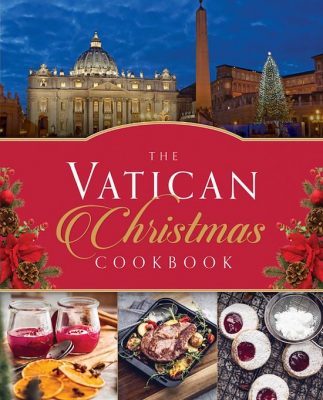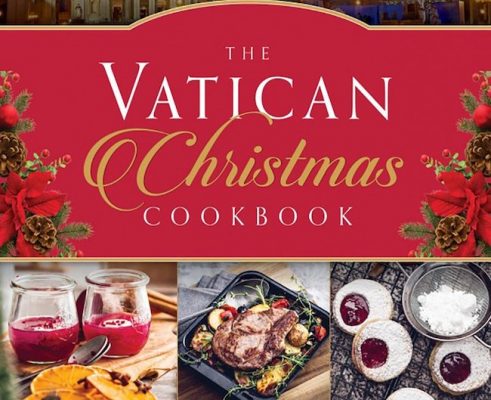“The Vatican Christmas Cookbook” by David Geisser and Thomas Kelly. Sophia Institute Press (Manchester, New Hampshire, 2020). 192 pp., $34.95.
By Tony Gutiérrez | Catholic News Service
Four years after “The Vatican Cookbook” became a best-seller by revealing the secrets of the papal palate, authors David Geisser and Thomas Kelly have a sequel geared specifically for the holiday season in “The Vatican Christmas Cookbook.”
The cookbook is full of historical tidbits mixed in with recipes ranging from the sweet to the savory … for those who can afford them.
The authors divide this sequel into sections following the first part of the liturgical year. The first covers Advent, followed by Christmas Eve, Christmas and the Epiphany. Geisser, a celebrated chef and former member of the Pontifical Swiss Guard, and Kelly, a veteran journalist, work together to weave the foods traditionally prepared during that season with some details about their history and how some of those customs came about.
“The Joy of Fondue,” a subsection under “Christmas,” provides a historical footnote about the dish. According to the authors, some “farm families made good use of a few cheese remnants, some stale bread and a little wine, managing to conjure up a warm communal meal on a cold winter’s night.”
The idea of poor families coming together to share what little they had, reminiscent of the folk story “Stone Soup,” helps the reader appreciate the spirit of the season.
The reader gains a sense of the history of not only the celebration of Advent and Christmas in the early church, but also how the Swiss Guard came to be the pope’s personal bodyguards. The authors acknowledge that in some cases, the evangelists tell the story better than anybody else, so they introduce the “Christmas” section with a passage from Luke and the “Epiphany” section with a passage from Matthew.
The book also includes historical anecdotes about several popes in the Christmas season. St. Leo the Great is described as “the pope who saved Christmas,” because he stopped Attila the Hun and his forces at the gates of Rome. Particularly timely is the story of Pope Benedict XV leading the church during not only the First World War, but through the Spanish flu pandemic.
Geisser recalled his first Christmas as a Swiss Guard in service to St. John Paul II during midnight Mass in 1981. The pontiff had just recovered from an assassination attempt and hadn’t quite returned to his old energetic self until that evening when “I witnessed the resurgence of the Holy Father,” he recalls. “He was energized by the profound meaning of this night.”

Other sections include Christmas desserts and “Christmas around the world.” The authors feature traditions in Pope Francis’ native Argentina and from the home of the papal bodyguards, Switzerland, among others.
Aside from the introductions, unfortunately, there’s no other tie to the diversity of the church. There is no identification for which nations contributed what recipes in this section, with the exception of the “Fajitas Argentine,” which includes its country of origin in its name.
While the recipes themselves are very easy to follow, access to the ingredients may come at a cost.
Several recipes call for specialty meats such as duck or veal or for expensive liquors or wines. The “Egg Williams Soufflé” called for Poire Williams brandy. The cookbook includes some background on the spirit, noting that some “elite producers” attach the bottles to buds on a pear tree, so the pear grows inside the bottle. The page also includes a note that the “crème fraiche and Williams are both worth the extra effort,” i.e., extra cost, “but you may substitute sour cream for the crème and a good-quality cognac for the brandy.” Without a cognac handy, I resorted to my go-to Christian Brothers brandy.
That’s not to say there aren’t recipes more suitable to the common man. Having never made a lasagna before, the recipe for the “Lasagna Bolognese” was very simple to follow and tasted like I’d ordered it at a restaurant. In fact, the instructions were so user-friendly, I felt comfortable letting my 4-year-old son help with the preparation.
Some of the featured dishes don’t have to be limited to Christmas. The “Roast Christmas Turkey” recipe could be used for Thanksgiving, while there are plenty of meatless dishes such as the “Linguine Carbonara” or “Caponata Gamberoni” for those Catholics who abstain from meat on Fridays year-round.
Readers will come away from this book with a greater appreciation for liturgical traditions during this time of year and a few recipes they can try at home, but they should also be aware that some of these dishes won’t be able to be prepared at home due to financial, geographical or other limitations.
Tony Gutiérrez is a former editor of The Catholic Sun, news outlet of the Diocese of Phoenix, and a freelance journalist based in Cave Creek, Arizona.






















